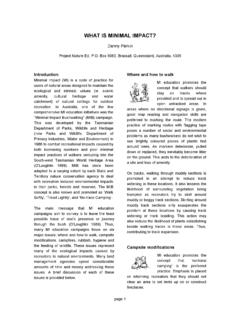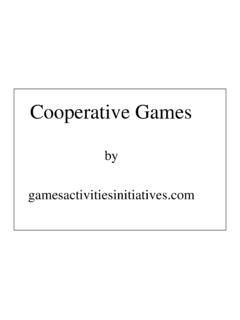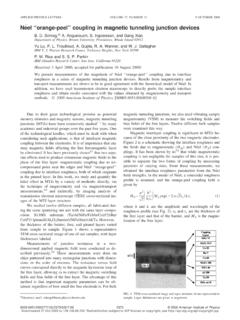Transcription of Providing for a diverse range of outdoor recreation ...
1 This paper was first published in Australian Parks and Leisure, 2(3), 41-47, 2000. Providing for a diverse range of outdoor recreation opportunities: a " micro -ROS" approach to planning and management Danny Parkin1, Dave Batt 2, Brett Waring3, Emma Smith1 and Helen Phillips2. 1. Forest Management, Queensland Department of Natural Resources 2. Sport and recreation Queensland, Queensland Department of Communication and Information, Local Government, Planning and Sport 3. Forest Allocation and Use, Queensland Department of Natural Resources Abstract In South East Queensland, a consortium of public sector agencies are developing a micro -ROS approach to the recording of outdoor recreation opportunities across a range of public land tenures. The basis of this data gathering process is a landscape classification system that describes individual recreational sites according to their biophysical, social and managerial attributes.
2 This process will allow the current range of combinations of outdoor recreation activity and landscape setting to be recorded and facilitate an activity x setting approach to recreation planning and management. Such a coordinated and uniform approach to the collection of outdoor recreation data has not previously occurred in South East Queensland. This project will significantly contribute to effective and efficient provision of public sector outdoor recreation services, provision of a wide range of high quality outdoor recreation opportunities at a regional level and more effective integration of outdoor recreation in land use decision making. Introduction modified it for specific purposes (Driver et al The provision and management of outdoor 1987).
3 recreation opportunities on public lands is a complex business. The determination of ROS literature is extensive. Authors have appropriate settings in which recreators may written about its application (Clark 1982;. obtain a particular recreational experience is Manning 1985 Jubenville 1989, Smith equally challenging. One of the tools available & Lipscombe 1999), its misuse (Van Oosterzee to recreation planners and land managers to 1984, Richards & Heywood 1999b) and the meet these challenges is the Recreational operational constraints inherent in it (Jubenville, Opportunity Spectrum (ROS). The ROS is a Twight & Becker 1987). The ROS can be used conceptual framework designed to help clarify for a variety of management purposes (Driver &. relationships between recreational settings, Brown 1978; Stankey & Wood 1982; Clark activities and experiences (Clark & Stankey 1982), or - in its most basic form - to promote 1979; Clark 1982).
4 In this framework, recreational diversity (Manning 1986; Hammitt biophysical, social and managerial attributes & Cole 1987). It can also be used to identify are used to describe recreation sites. It was first existing or potential recreation opportunities in used by the United States Department of an area or used to define the relative sensitivity Agriculture Forest Service in the late 1970's. of an area to recreational impact (Clark 1982). Since then, many agencies (including many Australian land and natural resource It has also been reported that the ROS has management agencies) have adopted the been used inappropriately to allocate original Clark and Stankey ROS as part of their recreational settings in relatively small recreation planning frameworks or have individual landholdings rather than on a PO Box 5063.
5 Brassall QLD 4305. regional basis (Van Oosterzee 1984). Other large areas for the provision of recreational criticisms of the ROS system stem from opportunities. The concept also allows relatively attempts to apply the ROS's zone-based small activity-sites to be identified and procedure to the classification of individual described appropriately, thus ensuring that settings (Richards & Heywood 1999a). small, but significant sites are properly However, classification of individual considered, rather than being lost in broadscale recreational settings is an important decisions. consideration - especially, where particular types of settings are rare (eg. small isolated The micro -ROS concept is not new to the areas of naturalness in otherwise large areas of recreation planning and management literature.)
6 Modified landscape) or unique (eg. the only site Jubenville (1989) and Richards and Heywood in a large area which is suitable for a particular (1999a) have expressed the need to consider outdoor recreation activity). individual recreation nodes within broader categories. The recreation setting inventory and Given that most of the valid criticisms of ROS classification system devised by Richards and refer to misuse of the concept rather than Heywood (1999a) encapsulates the concept of fundamental flaws in the concept, it is a micro -ROS approach to the planning and reasonable to accept that the underlying management of recreation opportunities. Their philosophy and intent of the ROS are sound. system considers individual recreation sites as This assumption is supported by the fact that a opposed to the broadscale zonal approach of number of well accepted and regularly used the original Clark and Stankey ROS.
7 recreation planning and management concepts including Limits of Acceptable Change (LAC) Richard and Heywood's multiple attribute (Stankey et al 1985, Prosser 1985), Visitor approach to landscape classification also has a Activity Management Process (VAMP) number of distinct advantages over the implied (Environment Canada & Park Service 1991) lineal relationship between classes in the ROS. and Visitor Impact Management (VIM) (Graefe, This failing was also highlighted by Manning Kuss & Loomis 1986, Graefe, Kuss & Vaske (1985 & 1999). However, a limitation of 1990) are either derived from the ROS or Richards and Heywood's classification system strongly related to it. is that it does not consider individual settings which are small and heterogeneous in Used for the purpose for which it was intended, character (eg.)
8 Small bush clearings that are the ROS provides a vehicle to integrate and used occasionally) or large and homogeneous coordinate recreation activities spatially and in nature (eg. grassed floodways) as settings temporally with other resource uses and where outdoor recreation may occur (1999a, management activities. The development of a p44). It is clear that while Richards and micro -ROS approach to the identification and Heywood's classification system has management of outdoor recreation sites across progressed our knowledge, use and availability the landscape will further enhance the value of of recreational land classification planning tools, the ROS concept as a planning and it does not provide for a full taxonomy of management tool. combinations of outdoor recreation activities and settings.
9 The micro -ROS Concept To be of value, a recreational landscape There are several advantages of an information classification system should be capable of rich " micro -ROS" approach. Firstly, the concept identifying even small areas of relatively rare recognises that small areas of relatively rare outdoor recreation settings independent of the recreation settings are just as important as tenure of the land on which they are located. page 2. PO Box 5063. Brassall QLD 4305. This is important because a significant outdoor recreation values in the context of other proportion of recreation planners, decision potential land uses. makers and participants assume that land tenure is reliably related to the biophysical, social and managerial characteristics of an The development of a micro -ROS.
10 Activity site. A frequent assumption is that all system for the classification of wild-natural-remote sites are located in national landscapes parks or that all national parks contain wild- Landscape Classification System natural-remote sites. However, in Queensland methodology at least, some state forests, some private lands The Queensland Department of Natural and even grazing leases contain significant Resources (DNR) Forest Resources', Forest areas that are relatively wild, natural and Management and Forest Allocation and Use remote. units are committed to the Montreal Process (MPIG 1998) and the development of indicators In the landscape classification system proposed of sustainable forest management. They are in this paper, recreational sites are categorised also committed to the development of a truly by their relative naturalness derived from representative landscape classification system.








